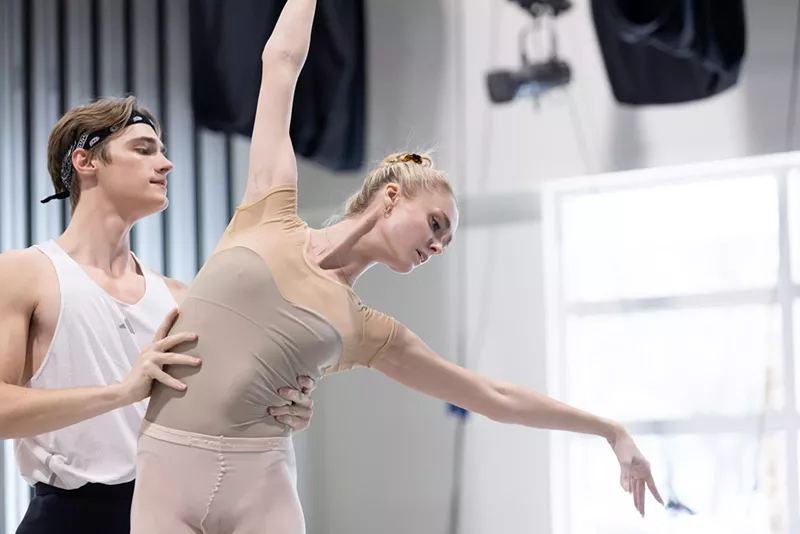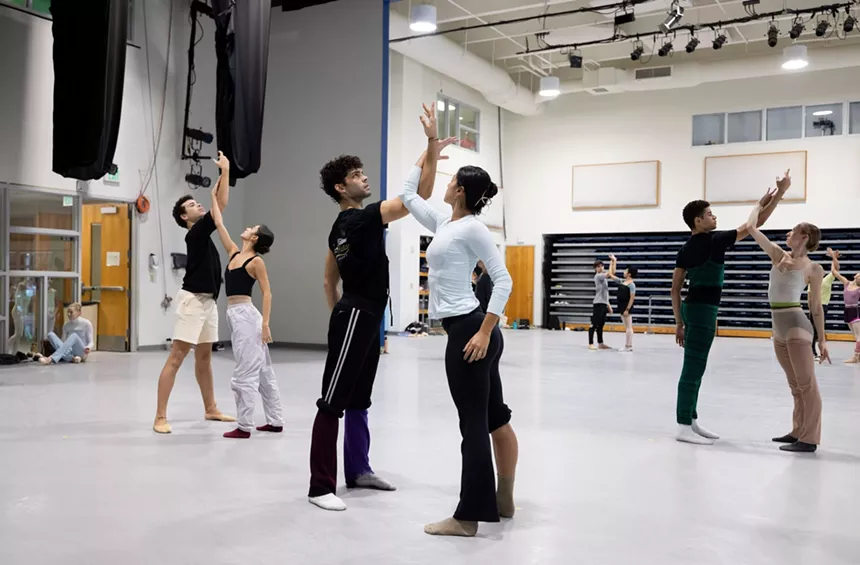Follow the music and find the dance emerges as the maxim of two young choreographers who bring the vigor of spring to Miami City Ballet's "Winter Mix." Intimately associated with the company, Durante Verzola and Margarita Armas are adding fresh works to the program, which also features the well-seasoned command of enshrined creators: George Balanchine and Jerome Robbins, giving Firebird flight to Stravinksy, and Alexei Ratmansky, witty and wily in Concerto DSCH, to Shostakovich.
The second mixed program of its season and the first of 2024, "Winter Mix," arrives at the Adrienne Arsht Center in Miami February 9-11 and then finishes at the Broward Center in Fort Lauderdale for two shows February 17 and 18.
The premiere of Verzola's Paganini, In Play is a dearly homegrown product from the 28-year-old Filipino-American who trained at MCB School, had his first choreographic effort staged there, and now works as part of its faculty. Last year, his mainstage MCB premiere, Sentimiento, sprang from company artistic director Lourdes Lopez's encouragement and benefited from the musical direction of in-house pianist Francisco Rennó.
Studio time with MCB dancers — among them former classmates, students, and long-time idols — has remained special for Verzola, who can mine their shiniest attributes as he works through his choreography.
"It makes it so easy," he says. "I have an understanding of how they move, how far they can go. I feel I know how to get the most out of them. And, acquainted with their personalities outside the studio, I play with that and capture those qualities in a more pristine way — it's just more fun. Nowadays, when I make a piece, I try to have the dancers find a kind of freedom. If that happens, I can let go more because it feels safer. And here we're always a couple of steps ahead."
As Verzola walks the halls of MCB, his schedule taking him from the ballet classes he teaches to rehearsals, he cherishes the connection between pedagogy and creative pursuits in the place that has harbored his striving and aspirations for so many years.
"My work as a teacher directly relates to my work as a choreographer," he says. "Whenever I am in the studio choreographing, I feel like I'm teaching, and whenever I am teaching, I feel like I'm choreographing. It kind of blends together, especially since my vocabulary is so classically based. I'll give combinations in ballet class that can later morph into phrases in rehearsals."
That holds true as he crisscrosses the country on freelance assignments — a burgeoning career spotlighted this January in one of the Guggenheim Museum's Works & Process presentations, "A Choreographic Portrait." This included, among its excerpts, a pas de deux Verzola created at DanceLabNY for men on pointe and culminated by sampling Paganini with MCB principal Renan Cerdeiro and corps member Mary Kate Edwards — all to show the choreographer's development, as he puts it, in "playing with and challenging musicality and phrasing."
Says Verzola, "Whenever I go off on these trips — for example, at Ballet Memphis, where I've been choreographing a new piece — I ask to teach company class as much as possible. Starting in the studio with the dancers, with the first steps they take as a group that day, just leads to better work in rehearsal time. I feel better connected that way and can make something out of it."
The choreographer recognizes that this allows him to present the performers not just as technicians but in their full humanity — the musical landscape, which is always his primary inspiration, as a panorama that stirs their hearts along with his. Sounds to sights, 19th-century composer Niccolo Paganini's "String Quartets No. 2 and 3," in two movements from each, let the casts scale on crests and brave vertiginous turns, some expectantly approached, others precipitous.
"I was already preparing for this when working on Sentimiento. That was centered around the piano, so I wanted to work with strings and was drawn to Paganini for his virtuoso qualities," says Verzola. "I structured this a bit more traditionally, with the different groups of dancers individually capturing the essence of the music while part of the same family."
Thus, the dancers can reflect the back and forth between the piercing prominence of a violin and the buzzing mergers of the ensemble. Throughout, Verzola heard "a friendly competition as musicians continue to one-up each other," which gave him the title and generated movement — often a regal display, punched up by the peacock-feather palette of costumes designed by his long-time artistic ally Martha Chamberlain.
"In certain passages, it seems Paganini is trying to put in as many notes as possible," Verzola contends, "and I want to show that arranging steps. I also thought that elevating the musicians at the back of the stage would add drama, giving the image of music as the life force to what's happening on stage."
Evocative sounds also seem to regulate life forces — sap and sunlight, pulse and breath — in Análogo, where Armas delves into the networks of nature. In this tripartite work, the music for the last section — Nina Simone at the piano for "You'd Be So Nice to Come Home To," the thirst of her singing eventually breaking through — resonated first with the choreographer. It led her to an overarching theme fortified by the other instrumental choices: Aukai's "Forest Scene" and "Tones of Longing" from Miss Meadow — like currents, both encircling and underlying, flowing into each other.
"My piece has to do with relationships we see in the world. There are a lot of analogies — from fauna to flora to humans," says the 23-year-old Miami native of Peruvian background, now residing near Seattle, about her second premiere for MCB, where she trained in ballet and has found her creativity nurtured.
Armas explains how Análogo opens with moody lighting by renowned designer Mark Stanley as if filtered through trees — a woodland setting where intertwined plant life awakens. She discovered a kindred spirit in costume designer Andrea Spiridonakos, a former MCB ballerina who draws from organic forms and colors. That lushness already stamps the dance before the second section takes up animal instincts, the partnerships among five men and five women evermore complex until they evolve into the jazzy closing interaction, its humanity redolent of hard-won romance.
The choreographer is so sensitive to the environment, be it stormy South Florida or the green-curtained Pacific Northwest — "I get inspiration just looking outside and taking in all the trees and vines and moss," she says — that her new piece is steeped in biophilia (how people seek connections through all forms of life). She acknowledges her heritage and the bond with her parents, who are Peruvian folk dancers, helped shape this.
"A lot of their presentations deal with storytelling and the elements of the Earth," she says. "It's seen in the colors of the costumes, the music. And that comes about very naturally in my choreography."
In the course of her scenario, she also urges the interpreters — for authenticity in feeling — to keep their individuality afloat.
"At the end," says Armas, "the dancers are sitting together in the front of the stage. It's a representation of the power of observance, that there's so much beauty in the similarities among all types of relationships."
– Guillermo Perez, ArtburstMiami.com
Miami City Ballet's "Winter Mix." 7:30 p.m. Friday, February 9, and Saturday, February 10, and 2 p.m. Sunday, February 11, at the Adrienne Arsht Center for the Performing Arts, 1300 Biscayne Blvd., Miami; and 7:30 p.m. Saturday, February 17, and 2 p.m. Sunday, February 18, at the Broward Center for the Performing Arts, 201 SW Fifth Ave., Fort Lauderdale; 305-929-7010; miamicityballet.org. Tickets cost $39 to $189.

Audio By Carbonatix
[
{
"name": "GPT - Billboard - Slot Inline - Content - Labeled - No Desktop",
"component": "16971022",
"insertPoint": "2",
"requiredCountToDisplay": "2"
},{
"name": "STN Player - Float - Mobile Only ",
"component": "18617832",
"insertPoint": "2",
"requiredCountToDisplay": "2"
},{
"name": "Editor Picks",
"component": "15769925",
"insertPoint": "4",
"requiredCountToDisplay": "1"
},{
"name": "Inline Links",
"component": "16575154",
"insertPoint": "8th",
"startingPoint": 8,
"requiredCountToDisplay": "7",
"maxInsertions": 25
},{
"name": "GPT - Rectangle 2x - Slot Auto-select - Labeled",
"component": "15782206",
"insertPoint": "8th",
"startingPoint": 8,
"requiredCountToDisplay": "7",
"maxInsertions": 25
},{
"name": "Inline Links",
"component": "16575154",
"insertPoint": "8th",
"startingPoint": 12,
"requiredCountToDisplay": "11",
"maxInsertions": 25
},{
"name": "GPT - Leaderboard to Tower - Slot Auto-select - Labeled",
"component": "15782207",
"insertPoint": "8th",
"startingPoint": 12,
"requiredCountToDisplay": "11",
"maxInsertions": 25
}
]









